Scottish COVID-19 Mental Health Tracker Study: Wave 4 Report
Wave 4 findings (data collected between 4 February and 9 March 2021.) indicate that young adults, women, people with physical and/or mental health conditions, and people in a lower socio-economic group are more likely to report experiencing poor mental health.
This document is part of 2 collections
2. Mental Health Outcomes
This section presents the mental health findings of Wave 4 of the Scottish COVID-19 (SCOVID) Mental Health Tracker Study which ran from 4th February and 9th March 2021.
The main mental health outcomes focused on are: depressive symptoms, anxiety symptoms, suicidal thoughts, psychological distress (as measured by the GHQ-12), and mental wellbeing. The study also included other correlates of mental wellbeing - such as loneliness, defeat, entrapment, social support, resilience, current distress (as measured by a single item), life satisfaction; these findings are reported more briefly. Only statistically significant changes and subgroup differences are reported here.
2.1 Suicidal thoughts
To measure suicidal thoughts, respondents were asked: 'how often have you thought about taking your life in the last week?', and were provided with options that ranged from "Never", "One day", "Several days", "More than half the days", "Nearly every day", and "I would rather not answer". For the purposes of this report, respondents who experienced any suicidal thoughts in the week prior to the Wave 4 questionnaire (i.e., one day or more) were included in the suicidal thoughts findings.
Wave 4 findings
Just over one tenth (10.4%) of respondents experienced suicidal thoughts within the week prior to completing the survey. The subgroups which reported higher rates of suicidal thoughts compared to their subgroup counterpoints were:
- Young adults (age 18-29 years)
- Younger women
- Those with a pre-existing mental health condition
There were some differences in rates of suicidal thoughts by age and sex, illustrated in Table 2.1. In the overall sample, there were no differences between men (10.4%) and women (10.5%) in rates of suicidal thoughts in the week prior to responding to the Wave 4 questionnaire.
The oldest age group (60+ years) reported the lowest rates of suicidal thoughts (2.4%), in contrast, around one sixth (17.0%) of young adults (18-29 years) reported suicidal thoughts, and over a tenth of those aged 30-59 years (12.8%). Across the age and sex subgroups, young women reported the highest rates of suicidal thoughts in the past week (19.9%), higher than that of young men (14.4%). Older women reported the lowest rates of suicidal thoughts (1.0%), lower than that of older men (4.0%). Findings for young adults should be interpreted with caution due to the small sample size.
| Sex | Aged 18 - 29 years (n=557) | Aged 30 - 59 years (n=1177) | Aged 60+ years (n=766) | Total (n=2500) |
|---|---|---|---|---|
| All adults | 17.0% | 12.8% | 2.4% | 10.4% |
| Men | 14.4% | 12.9% | 4.0% | 10.4% |
| Women | 19.9% | 12.8% | 1.0% | 10.5% |
Respondents' backgrounds also had a bearing on the rates of suicidal thoughts reported, and some of these are displayed in Figure 2.1. Individuals from the lower SEG reported higher rates of suicidal thoughts in the last week (11.4%) compared to those from the higher SEG (9.9%). There was also a stark difference in the reporting of suicidal thoughts in those with or without a pre-existing mental health condition; those with a pre-existing mental health condition reported higher rates of suicidal thoughts (25.6%) than those without a pre-existing mental health condition (8.5%). There were no differences in suicidal thoughts for those with or without a pre-existing physical health condition.
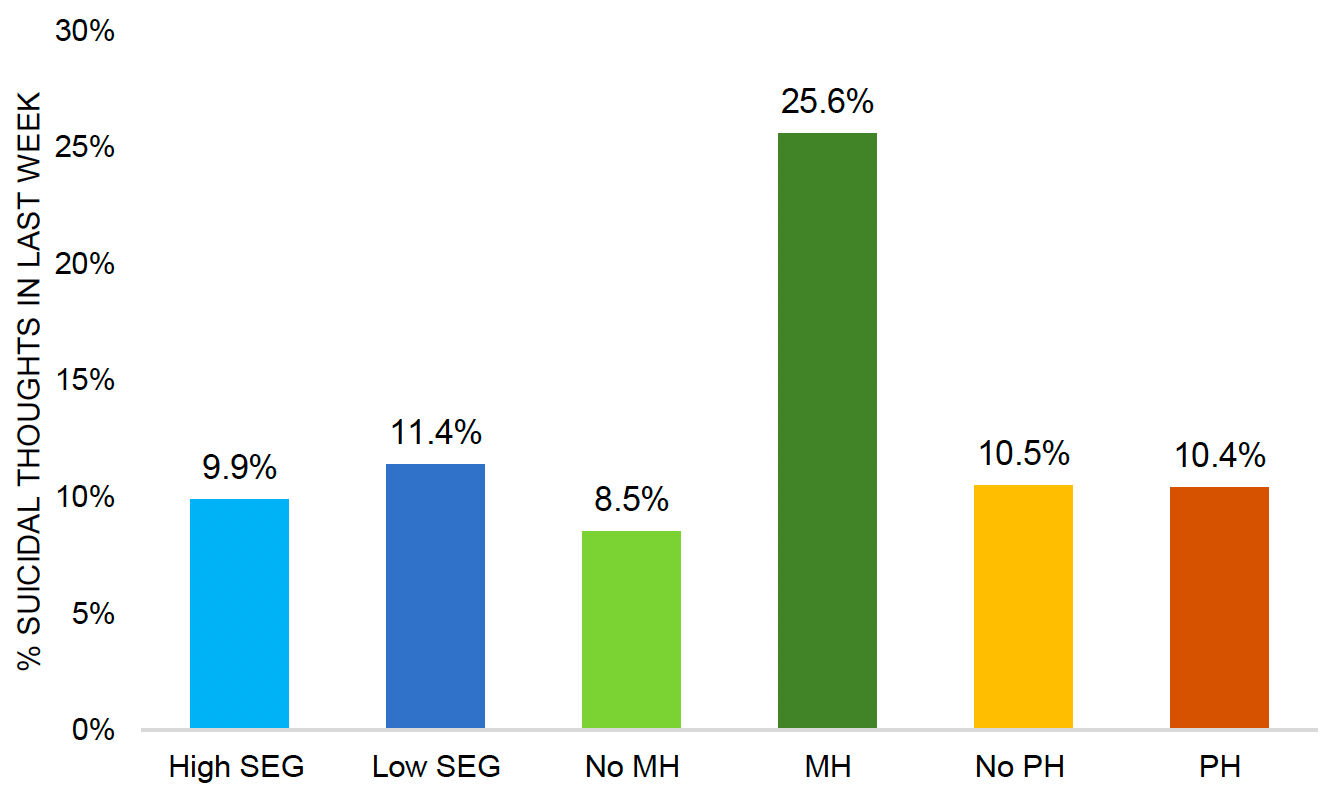
Differences in financial and home life circumstances also appear to be associated with varying rates of suicidal thoughts. Respondents who had experienced a change in working status (e.g., working from home, lost job or furloughed) since the COVID-19 pandemic reported higher rates of suicidal thoughts (13.7%) compared to those respondents who had not experienced a change (8.0%). Further, people who lived with someone were more likely to report suicidal thoughts (11.2%) than those who lived alone (7.5%). There were differences reported in rates of suicidal thoughts in carers, as individuals with caring responsibilities (15.2%) were more likely to report suicidal thoughts than those with no caring responsibilities (9.4%).
Changes across the waves
Looking at changes across the waves, the proportion of respondents reporting suicidal thoughts increased from Wave 1 (8.2%) to Wave 2 (14.9%), followed by a decrease in the proportion who reported suicidal thoughts at Wave 3 (8.6%), before rising again at Wave 4 (11.2%). This change over time is illustrated in Figure 2.2.
The proportion of several subgroups reporting suicidal thoughts increased from Wave 3 to Wave 4, including:
- 30-59 year old men,
- Individuals with no pre-existing mental health condition,
- Respondents who are key workers.
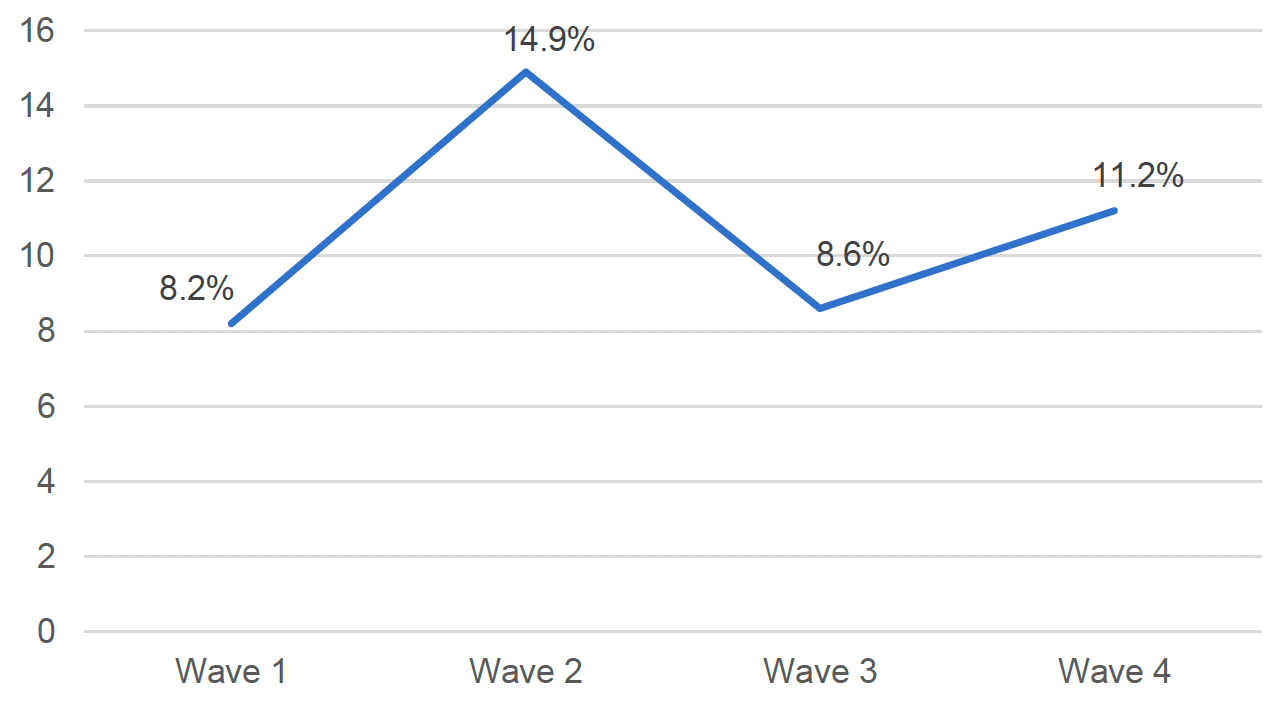
Looking at age and sex, from Wave 3 to Wave 4, for men aged 30-59 years, there was an increase in suicidal thoughts from Wave 3 (9.3%) to Wave 4 (14.2%). There were no statistically significant changes in rates of suicidal thoughts for women aged 60+ years (Wave 3: 1.0%; Wave 4: 0.7%), for men aged 60+ years (Wave 3: 2.9%; Wave 4: 4.0%), or for woman aged 30-59 years (Wave 3: 12.4%; Wave 4: 13.9%). Due to the loss at follow-up, it is not possible to report the changes for the 18-29 year old age group over the waves.
Looking more closely at the subgroups based on background and health, some differences in suicidal thoughts emerged (Figure 2.3). Specifically, the proportion of those with no pre-existing mental health condition reporting suicidal thoughts in the week prior increased from 5.5% in Wave 3 to 8.5% in Wave 4, whereas those with a pre-existing mental health condition reported no change (Wave 3: 31.9%; Wave 4: 31.1%).
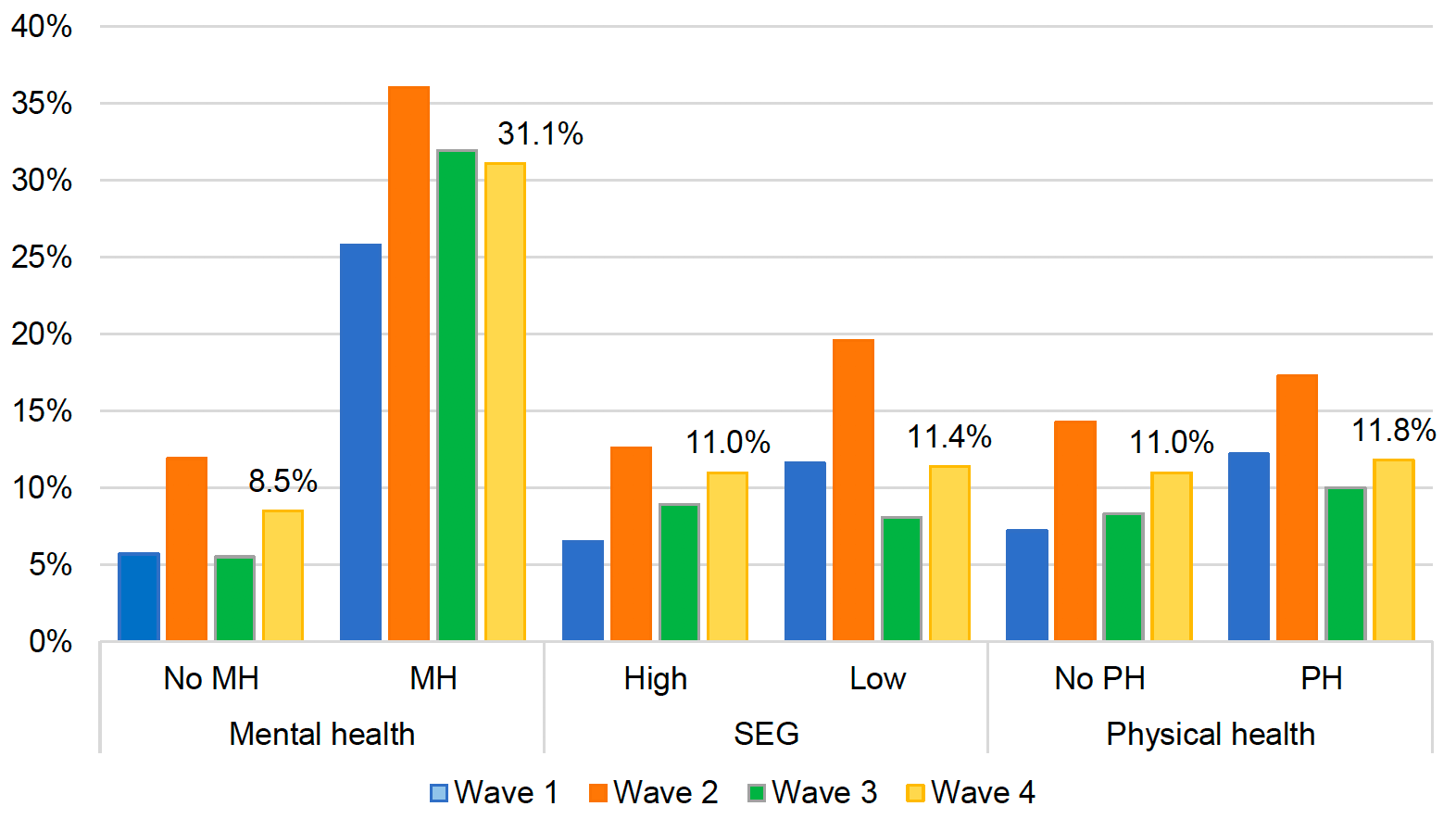
Findings also suggest that other employment and household factors were associated with changes in rates of suicidal thoughts. Specifically, rates of suicidal thoughts increased for respondents who were key workers from Wave 3 (9.4%) to Wave 4 (15.0%). No other significant subgroup changes were found from Wave 3 to Wave 4.
2.2. Depressive symptoms
This study's findings on moderate to severe depressive symptoms are based on participants' responses to questions on the mental health measure called the Patient Health Questionnaire (PHQ-9; Kroenke et al., 2001), which assesses frequency of depressive symptoms over the previous two weeks.[16]
Wave 4 findings
Wave 4 of the SCOVID Study shows that nearly a quarter (23.5%) of the overall sample met the cut-off for moderate to severe depressive symptoms. The following groups reported higher rates of moderate to severe depressive symptoms than their subgroup counterparts:
- Young adults (age 18-29 years old)
- Women, in particular young women (age 18-29 years old)
- Respondents from the lower SEG
- Those with a pre-existing mental health condition
- Those with a pre-existing physical health condition
There were clear differences in moderate to severe depressive symptoms according to age and sex, illustrated in Table 2.2. For example, in the overall sample, women were more likely to report symptoms that met the cut-off for moderate or severe depressive symptoms (26.1%) than men (20.8%). In addition, just over a third of young adults (18-29 year olds) reported depressive symptoms (35.8%), compared to a quarter of those in the middle age group (30-59 years) (25.3%) and a tenth of the oldest age group (60+ years) (11.9%). Furthermore, young women between 18-29 years old reported higher rates of depressive symptoms at 42.1%, compared to 29.6% of men in the same age group. Findings for young adults should be interpreted with caution due to the small sample size.
| Sex | Aged 18 - 29 years (n=557) | Aged 30 - 59 years (n=1177) | Aged 60+ years (n=766) | Total (n=2500) |
|---|---|---|---|---|
| All adults | 35.8% | 25.3% | 11.9% | 23.5% |
| Men | 29.6% | 22.2% | 12.0% | 20.8% |
| Women | 42.1% | 28.1% | 11.8% | 26.1% |
Beyond age and sex, respondents' backgrounds also had a bearing on the likelihood of reported rates of moderate to severe depression, illustrated in Figure 2.4. Respondents in the lower SEG reported higher rates of depressive symptoms (27.0%) compared to those in the higher SEG (21.4%).
An individual's health may be associated with their experience of depressive symptoms. Around two thirds of respondents with a pre-existing mental health condition reported depressive symptoms (63.5%), compared to around one sixth of those without a pre-existing mental health condition (17.5%). Respondents with a pre-existing physical health condition reported higher rates of depressive symptoms (34.9%) than those with no pre-existing physical health condition (20.3%).
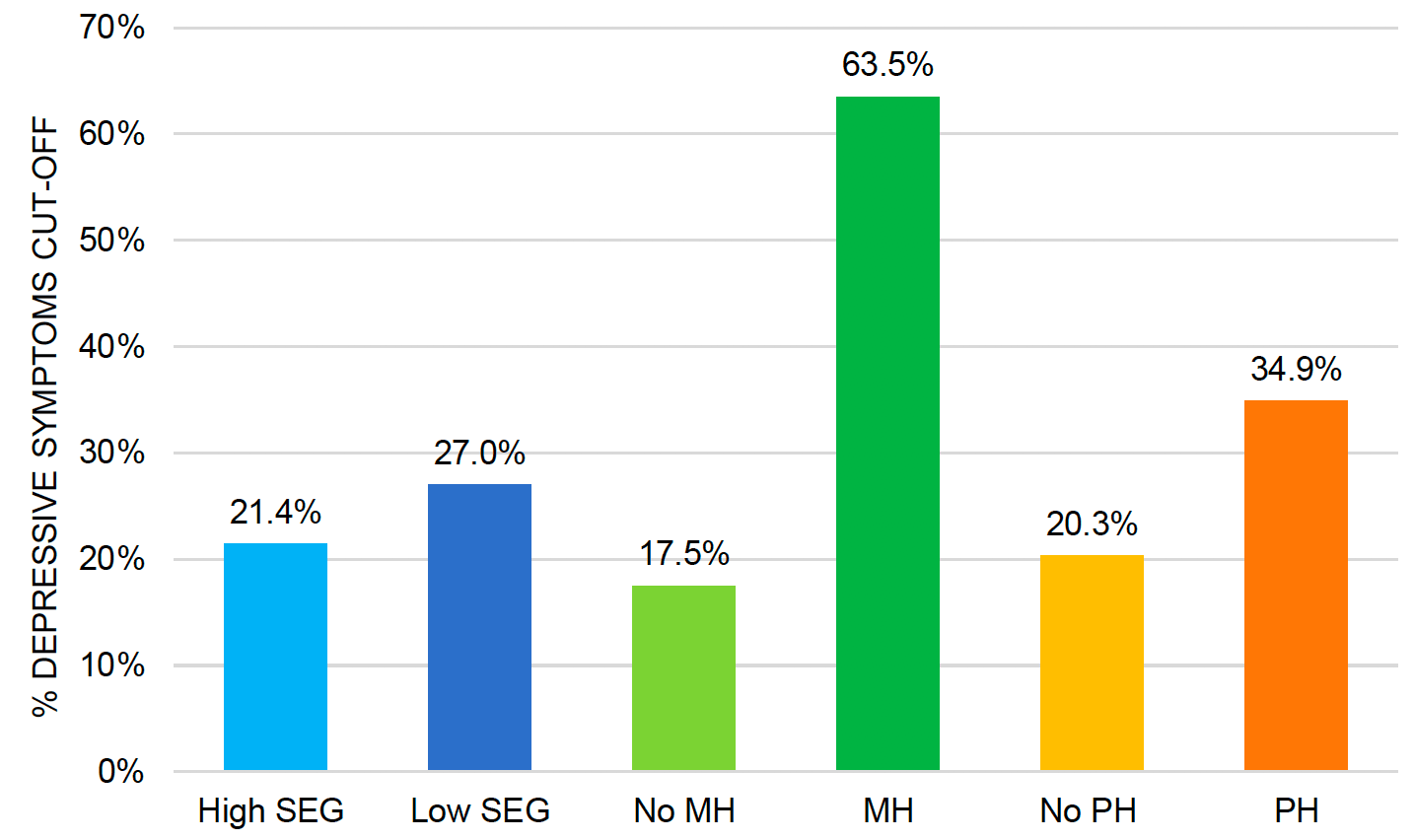
Differences in financial and home life circumstances also appear to be associated with varying rates of depressive symptoms, and indicate that those living with greater financial uncertainty or added responsibilities at home may be a greater risk for depressive symptoms. For example, respondents who reported a change to their working status (e.g., furloughed, lost job or reduction in pay) since the COVID-19 pandemic experienced higher rates of depressive symptoms (26.8%) than those that had experienced no change in their working status (21.0%). Those with dependents under 5 years old (30.9%) reported higher rates of depressive symptoms compared to those with no dependents under 5 (23.4%). Respondents that had any unpaid caring responsibilities (34.9%) reported higher rates of depressive symptoms than those with no additional caring responsibilities (21.0%). Finally, people with no access to outdoor space in their homes (32.0%) reported higher rates of moderate to severe depressive symptoms than those with access (22.7%).
Changes across the waves
Looking at respondents who had completed every wave, there was an increase in the rates of moderate to severe depressive symptoms from Wave 3 (21.1%) to Wave 4 (25.0%). Looking across the waves, rates of depressive symptoms at Wave 4 (25.0%) were higher than at any of the previous three waves (Wave 1: 20.6%; Wave 2: 22.3%, Wave 3: 21.1%). See Figure 2.5 for changes in depressive symptoms over time.
A number of subgroups saw increases in rates of moderate to severe depressive symptoms from Wave 3 to Wave 4, including:
- Men aged 30-59 and 60+ years
- Respondents with no mental health condition
- Individuals from the lower SEG
- Respondents living in a rural area
- Those who had no dependents aged under 16 years old.
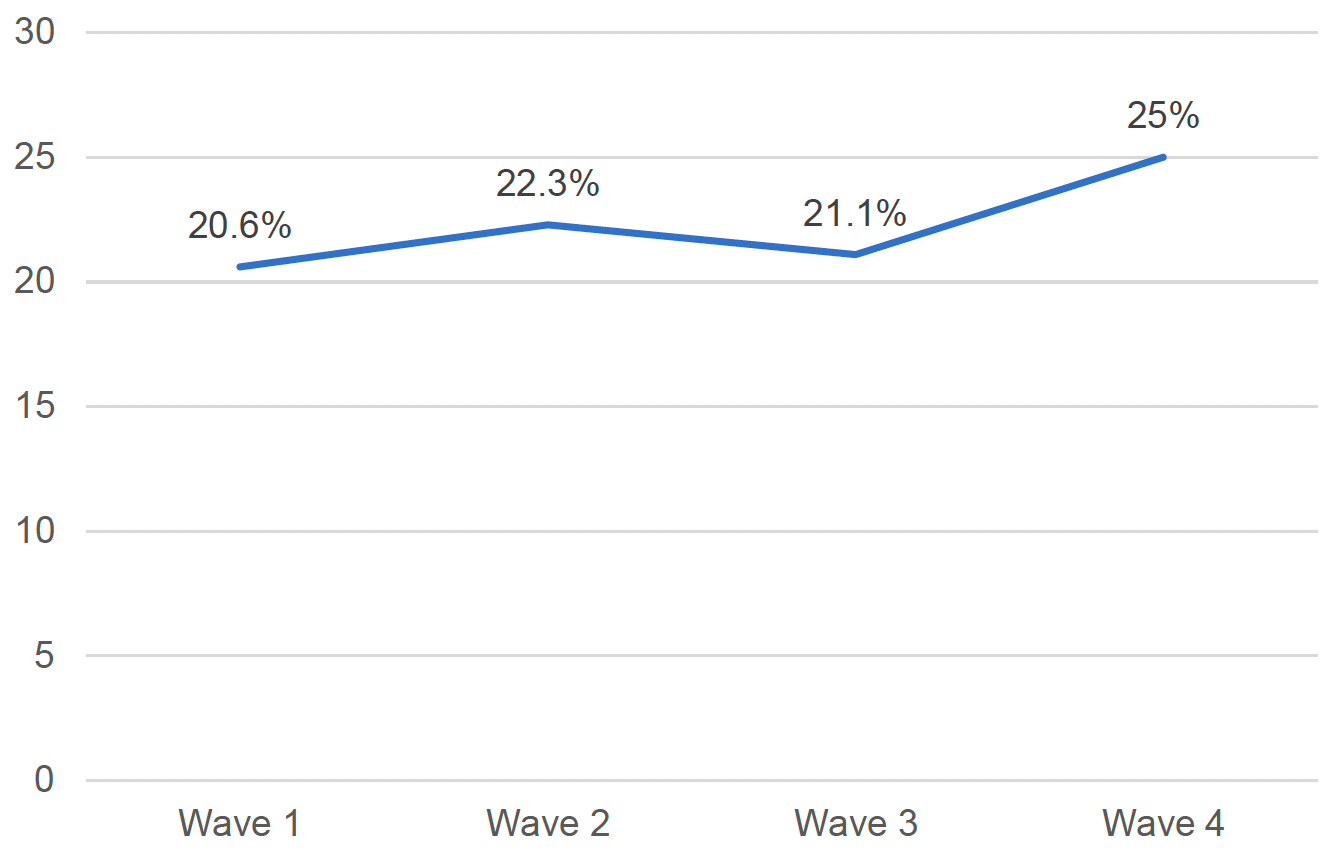
Some differences by age and sex from Wave 3 to Wave 4 were found. There were no statistically significant differences in the changes in rates of depressive symptoms for women aged 30-59 years (Wave 3: 27.1%; Wave 4: 29.9%), nor for women aged 60+ years (Wave 3: 13.9%; Wave 4: 13.2%) compared to the other age and sex subgroups. Rates of depressive symptoms for 30-59 year old men increased from Wave 3 (15.6%) to Wave 4 (23.6%), and increased for 60+ year old men (Wave 3: 9.6%; Wave 4: 12.8%). Due to the loss at follow-up, it is not possible to report the changes for the 18-29 year old age group over the waves.
Looking more closely at changes in moderate to severe depressive symptoms by health and background factors, some differences emerged (see Figure 2.6). Those with no pre-existing mental health condition reported higher rates of depressive symptoms at Wave 4 (18.7%) compared to Wave 3 (14.0%), whereas those with a pre-existing mental health condition reported similar rates at Wave 3 (66.6%) and Wave 4 (65.7%). Additionally, a higher proportion of the lower SEG reported depressive symptoms at Wave 4 (32.6%) than at Wave 3 (20.8%).
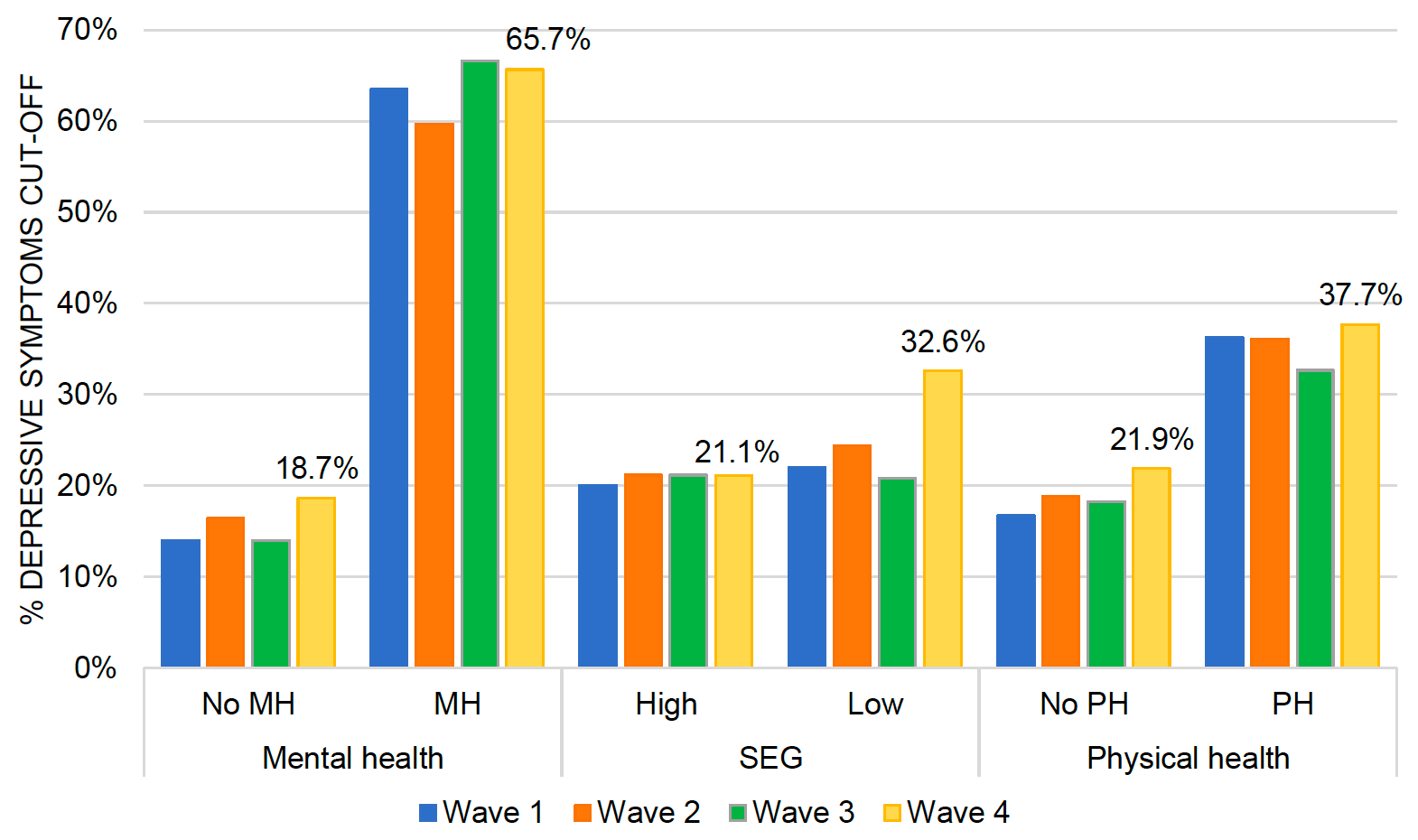
There were some changes between Wave 3 and Wave 4 in rates of moderate to severe depressive symptoms by household factors. For example, for respondents with no dependents under 16 years old, rates of depressive symptoms increased from Wave 3 (19.8%) to Wave 4 (24.7%), compared to those with dependents under 16 years whose rates did not change (Wave 3: 25.5%; Wave 4: 26.0%). Respondents who lived in a rural area reported an increase in the rates of depressive symptoms from Wave 3 (19.5%) to Wave 4 (30.1%), compared to those who lived in urban areas whose rates did not change (Wave 3: 21.5%; Wave 4: 23.7%).
2.3. Anxiety symptoms
Anxiety symptoms were assessed using the mental health measure called the Generalised Anxiety Disorder (GAD-7; Spitzer et al., 2006) scale, which asks about frequency of anxiety symptoms in the last 2 weeks. For the purposes of this report, the clinical cut-off for moderate to severe anxiety (score ≥10) was reported, indicating anxiety symptoms that may require further treatment.
Wave 4 findings
Wave 4 of the SCOVID Study indicated that 16.2% of respondents met the cut-off for moderate to severe anxiety symptoms. A number of subgroups reported higher rates of moderate to severe anxiety symptoms compared to their subgroup counterpoints, specifically:
- Young adults (18-29 years old)
- Women
- Those with a pre-existing mental health condition
- Those with a pre-existing physical health condition
- Those from the lower SEG
Looking more closely at the findings there were differences in moderate to severe anxiety symptoms according to sex and age, displayed in Table 2.3. For example, when comparing sex only, women reported higher rates of anxiety symptoms (19.5%) than men (12.8%). There were also differences by age group: with 28.8% of young adults (18-29 year olds) reporting anxiety, compared to 15.5% of 30-59 year olds and 8.2% of 60+ year olds.
When looking at groups by both age and sex, further differences in the likelihood for experiencing moderate to severe anxiety arise. For example, young women aged between 18-29 years reported markedly higher rates of anxiety symptoms (37.0%) than younger men (20.8%). Findings for young adults should be interpreted with caution due to the small sample size. Older women reported the lowest rates of anxiety symptoms (7.8%) of the sample, followed by the rate of older men who reported these symptoms (8.7%).
| Sex | Aged 18 - 29 years (n=557) | Aged 30 - 59 years (n=1177) | Aged 60+ years (n=766) | Total (n=2500) |
|---|---|---|---|---|
| All adults | 28.8% | 15.5% | 8.2% | 16.2% |
| Men | 20.8% | 11.4% | 8.7% | 12.8% |
| Women | 37.0% | 19.3% | 7.8% | 19.5% |
Beyond age and sex, respondents' health and financial circumstances also had a bearing on the likelihood of reported rates of moderate to severe anxiety, illustrated in Figure 2.7. More respondents in the lower SEG (21.4%) experienced anxiety symptoms than those in the higher SEG (13.2%). Additionally, around half (48.9%) of those with a mental health condition reported anxiety symptoms, compared to only 11.3% of those with no mental health condition. Respondents with a physical health condition experienced higher rates of anxiety symptoms (23.9%) than those with no physical health condition (14.0%).
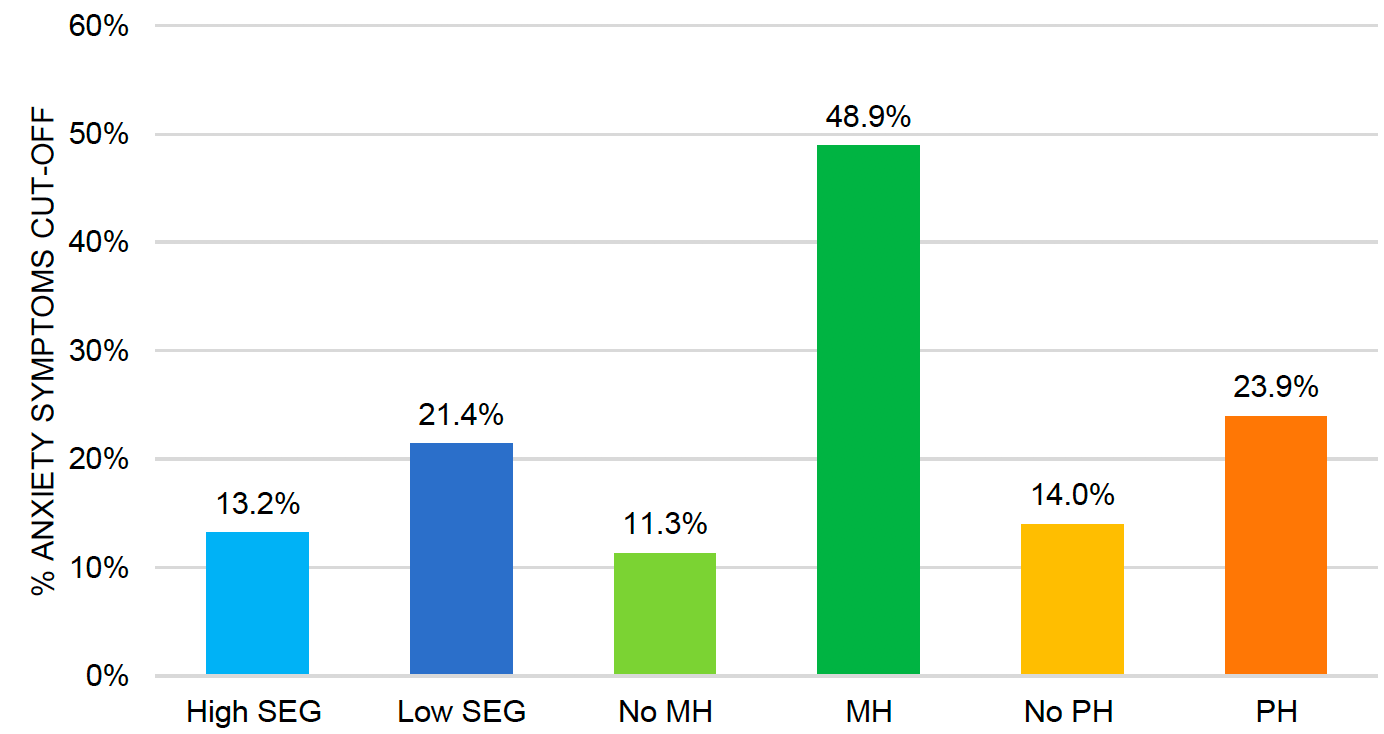
Differences in working life, home life, and carer circumstances appeared to be associated with rates of moderate to severe anxiety symptoms. For example, respondents whose working situation had changed during the COVID-19 pandemic (e.g., furloughed, lost job) reported higher rates of moderate to severe anxiety (20.7%) than those with no change (12.9%). Shifting focus to home-life circumstances, respondents who had caring responsibilities had a higher likelihood of anxiety symptoms (23.3%) than those who did not have any caring responsibilities (14.7%). Finally, people with no access to outdoor space in their homes (26.6%) reported higher rates of moderate to severe anxiety symptoms than those with access (15.3%).
Changes across the waves
Looking at the sample as a whole, there were no statistically significant changes in rates of moderate to severe anxiety symptoms from Wave 3 (15.0%) to Wave 4 (15.3%), or from Wave 4 to any previous wave. See Figure 2.8 for rates of anxiety symptoms across the waves.
Between Waves 3 and 4 there was a change in the proportion of the following subgroups reporting moderate to severe anxiety symptoms:
- Individuals living with dependents under 16 years old reported an increase in anxiety symptoms
- Respondents living in rural areas reported a decrease in anxiety symptoms
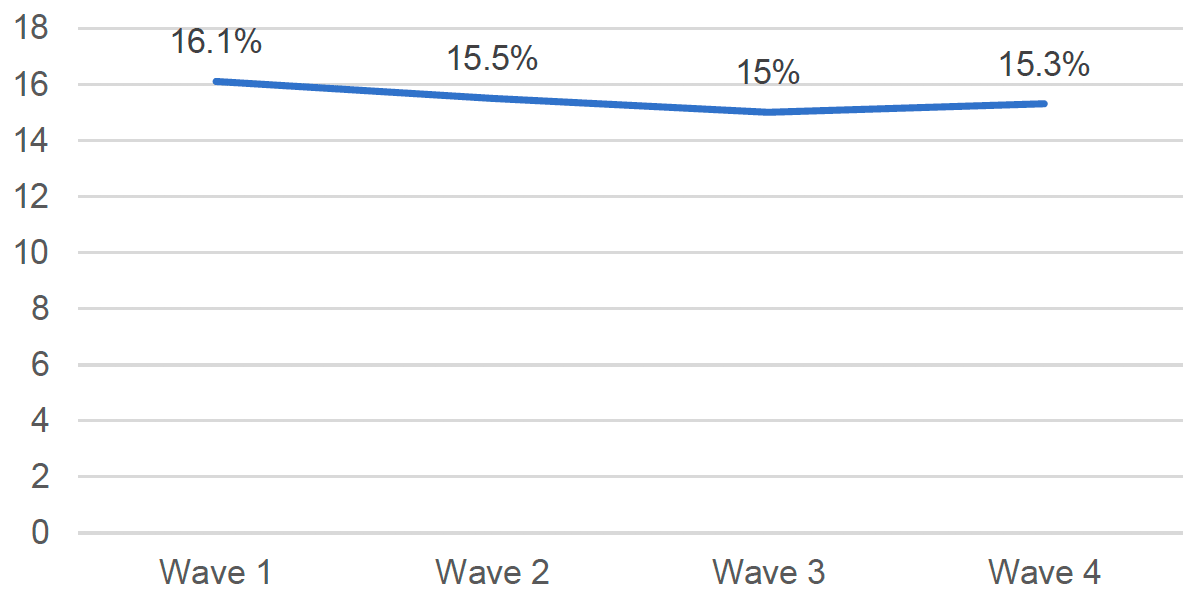
Looking at age and sex, there were no statistically significant differences in the changes in rates of anxiety symptoms by age and sex subgroups. Rates of anxiety symptoms did not change for women aged 30-59 years from Wave 3 (22.8%) to Wave 4 (19.4%). Men aged 30-59 years reported similar rates of anxiety symptoms at Wave 3 (10.0%) and Wave 4 (10.9%). For the 60+ age group, both men (Wave 3: 10.1%; Wave 4: 9.5%) and women (Wave 3: 8.8%; Wave 4: 8.5%) reported similar rates of moderate to severe anxiety symptoms across the waves. Due to the loss at follow-up, it is not possible to report the changes for the 18-29 year old age group over the waves.
Changes in rates of moderate to severe anxiety by background factors and health of respondents are illustrated in Figure 2.9. There were no statistically significant changes in moderate to severe anxiety symptoms across the pre-existing mental health condition, SEG, or pre-existing physical health condition subgroups.
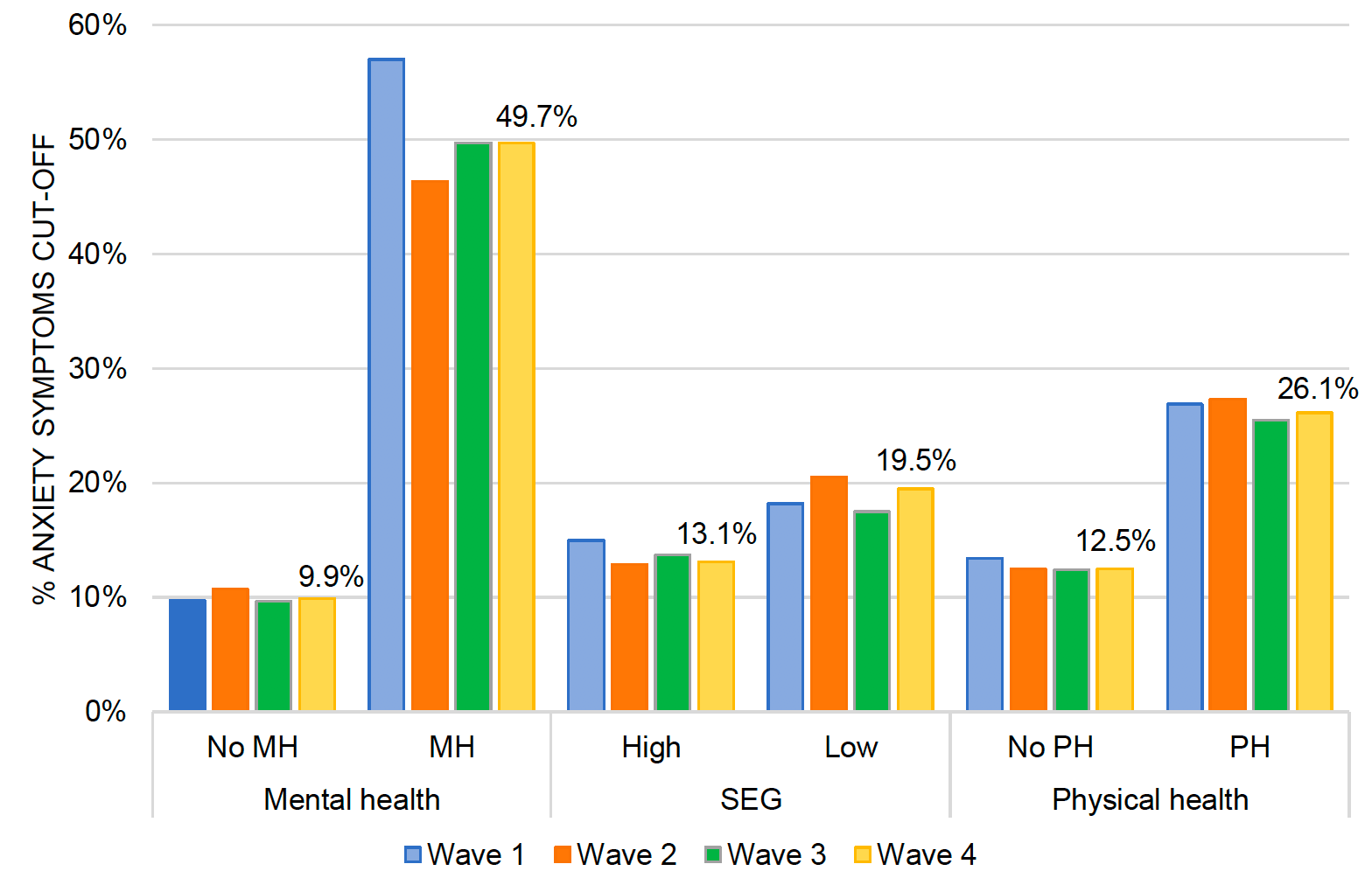
Looking at household subgroups, respondents living with dependents aged 16 years or younger reported an increase in their rates of anxiety from Wave 3 (15.1%) to Wave 4 (18.5%), and rates for those with no dependents under 16 years were similar from Wave 3 to 4 (Wave 3: 15.0%, Wave 4: 14.3%). Additionally, those living in rural areas reported a decrease in rates of moderate to severe anxiety symptoms from Wave 3 (17.5%) to Wave 4 (15.1%), compared to those in urban areas (Wave 3: 14.4%; Wave 4: 15.3%).
2.4. Psychological Distress (General Health Questionnaire)
The General Health Questionnaire (GHQ-12) is a psychological measure that assesses psychological distress and mental ill-health in the previous two weeks, including sleep, self-esteem, stress, despair, depression, and confidence. In this report, as consistent with other mental health research studies (McLean et al., 2018), GHQ-12 scores of four or more are reported because this cut-off is deemed a high GHQ-12 score and indicates the presence of a possible psychiatric disorder.
Wave 4 findings
Nearly one third (32.2%) of the sample recorded a high GHQ-12 score. Particular groups had elevated rates of high GHQ-12 scores compared to their subgroup counterpoints:
- Young adults (age 18-29 years)
- Women, specifically young women (18-29 years)
- Those with a pre-existing mental health condition
There were clear differences in rates of high GHQ-12 scores by sex and age, as presented in Table 2.4. Specifically, women were more likely to have a high GHQ-12 score (36.8%) than men (27.3%). Additionally, 50.2% of the younger age group (18-29 year olds) reported a high GHQ-12 score, compared to 31.4% of 30-59 year olds and 20.5% of 60+ year olds. Additionally, young women were also more likely to have a high GHQ-12 score (59.0%) compared to young men (41.6%). Findings for young adults should be interpreted with caution due to the small sample size. Across all the age and sex subgroups, older men reported the lowest rates of high GHQ-12 scores (17.4%), followed by older women (23.4%).
| Sex | Aged 18 - 29 years (n=557) | Aged 30 - 59 years (n=1177) | Aged 60+ years (n=766) | Total (n=2500) |
|---|---|---|---|---|
| All adults | 50.2% | 31.4% | 20.5% | 32.2% |
| Men | 41.6% | 26.7% | 17.4% | 27.3% |
| Women | 59.0% | 35.6% | 23.4% | 36.8% |
Beyond age and sex, respondents' backgrounds and health also had a bearing on the likelihood of reporting a high GHQ-12 score (Figure 2.10). Specifically, over half (52.8%) of those with a pre-existing mental health condition recorded a high GHQ-12 score, compared to just under a third of those with no pre-existing mental health condition (29.3%). Additionally, those with a pre-existing physical health condition reported higher rates of high GHQ-12 (37.7%) than those with no pre-existing physical health condition (30.8%).
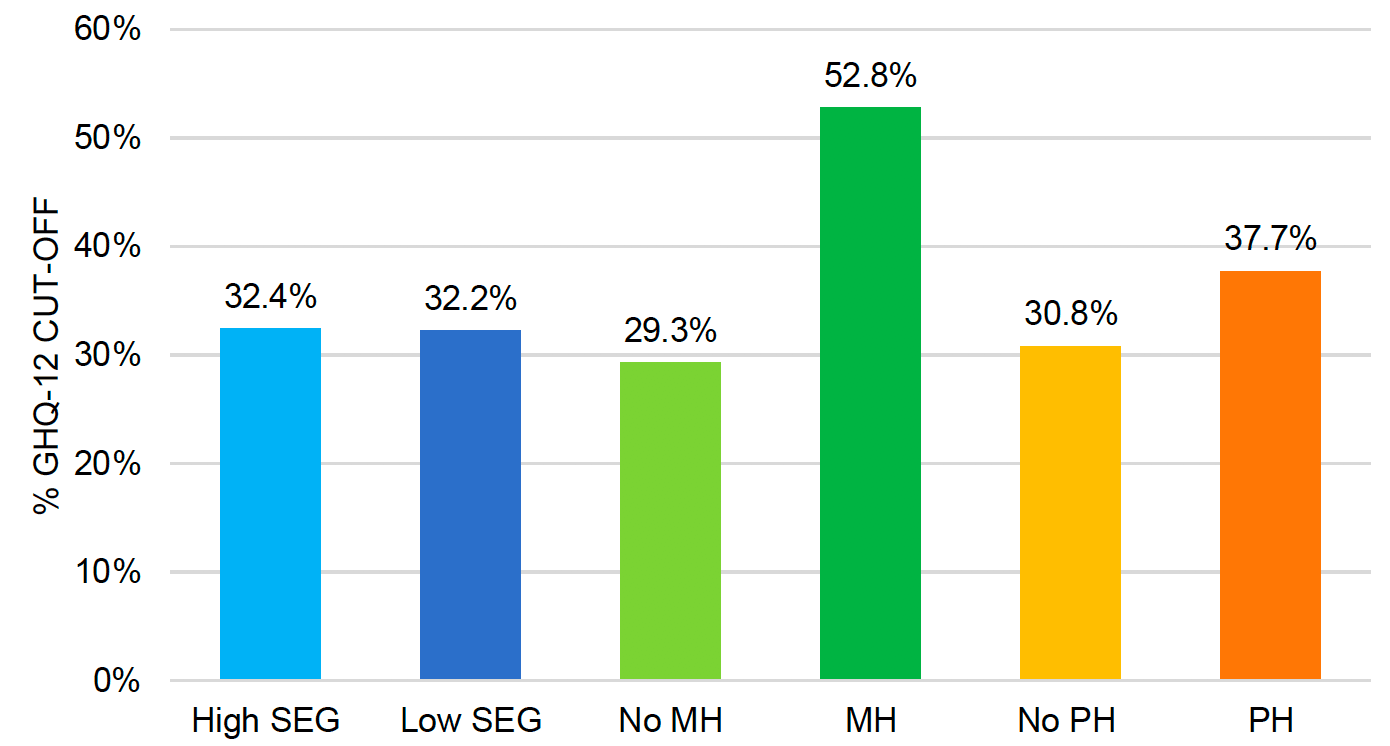
Differences in home life and carer circumstances also appear to be associated with varying rates of high GHQ-12 scores. For example, respondents whose household had dependents under 5 years old were more likely to have high GHQ-12 scores (40.4%) than those with none under 5 years (32.8%). Further, people who lived with others reported higher rates of high GHQ-12 (33.6%) compared to those who lived alone (27.8). In addition, just under half (46.3%) of respondents with caring responsibilities recorded a high GHQ-12 score, which was higher than those with no caring responsibilities (29.3%). Additionally, people whose working status had changed during the COVID-19 pandemic (i.e., lost job, furloughed) reported higher rates of high GHQ-12 (44.5%) than those with no change (23.3%).
Changes across the waves
Analysis suggests that the proportion of respondents who met the GHQ-12 cut-off for a possible psychiatric disorder did not change from Wave 3 (27.8%) to Wave 4 (26.9%). Although respondents reported a reduction in high GHQ-12 from Wave 1 (28.7%) to Wave 2 (25.9%), rates at Wave 4 were not statistically different from any previous wave (illustrated in Figure 2.11).
A decrease in rates of high GHQ-12 from Wave 3 to Wave 4 were found for particular subgroups:
- Respondents with a pre-existing mental health condition
- Individuals from the lower SEG
- Those with a pre-existing physical health condition
- People living in a rural area
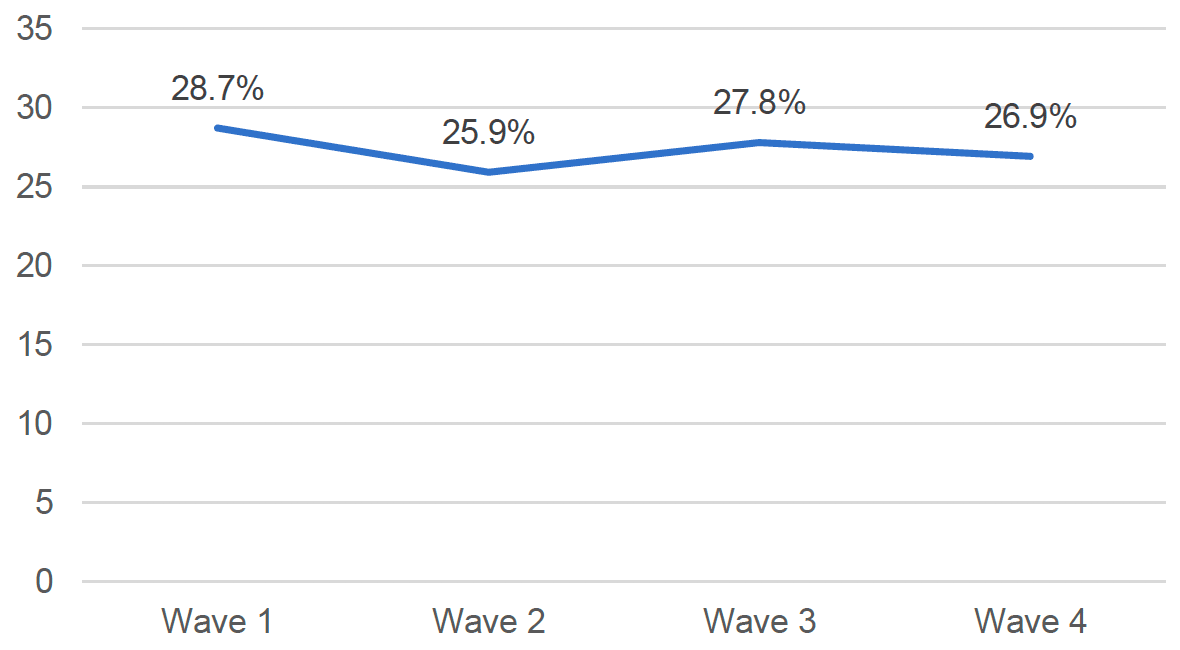
Looking more closely at rates of high GHQ-12 by age and sex, there were no statistically significant differences in the changes across these subgroups from Wave 3 to Wave 4. Within the 30-59 year age group, both women (Wave 3: 37.3%; Wave 4: 35.5%) and men (Wave 3: 29.1%; Wave 4: 24.9%) reported similar rates across these waves, although women still reported higher rates than men. Similarly, for those aged 60+ years, women (Wave 3: 21.0%; Wave 4: 21.7%) and men (Wave 3: 18.3%; Wave 4: 18.3%) reported similar rates across these waves. Due to the loss at follow-up, it is not possible to report the changes for the 18-29 year old age group over the waves.
Additionally, there were some changes in rates of high GHQ-12 scores by health and background factors, as displayed in Figure 2.12. Between Wave 3 and Wave 4, rates of high GHQ-12 scores decreased among respondents with a pre-existing mental health condition (Wave 3: 64.2% to Wave 4:48.1%), respondents with a pre-existing physical health condition (Wave 3: 42.9% to Wave 4: 37.5%), individuals from the lower SEG (Wave 3: 30.8% to Wave 4:26.6%), and those living in a rural area (Wave 3: 37.2% to Wave 4: 32.4%). No further statistically significant changes in rates of high GHQ-12 were reported from Wave 3 to Wave 4.
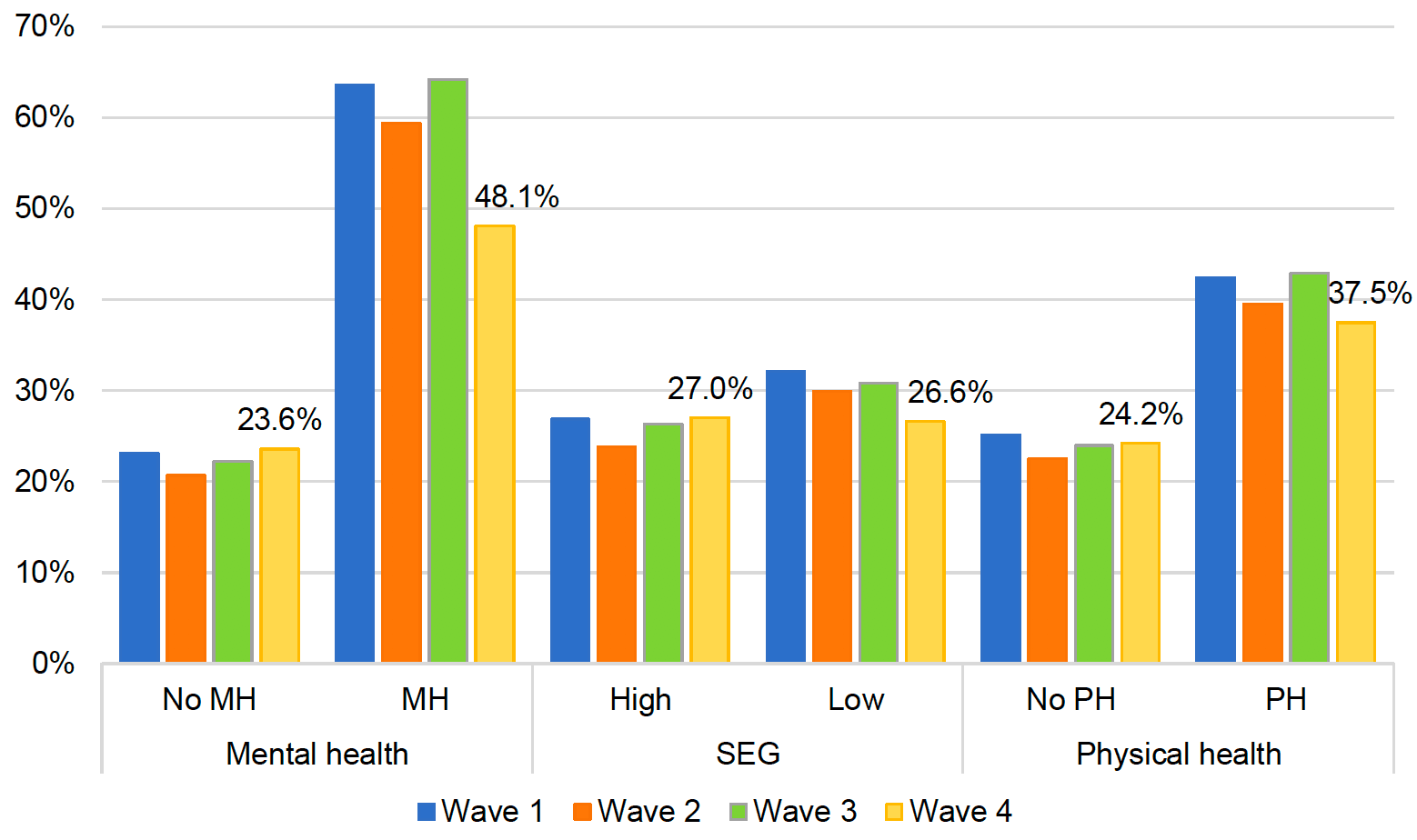
2.5. Mental wellbeing
Mental wellbeing is an important indicator of mental health and can indicate how protected an individual may be from mental health problems such as depression and anxiety. The SCOVID Study measured respondents mental wellbeing using the Short Warwick-Edinburgh Mental Well-being Scale (SWEMWBS). This scale measures the frequency of thoughts and feelings of mental wellbeing over the past two weeks; includes items such as feelings of optimism, feelings of being useful, and feeling that one is thinking clearly.
For the Short Warwick-Edinburgh Mental Well-being Scale (SWEMWBS)[19], a score is created for each individual by adding together their responses to each question. The scores range from 7 (indicating very low wellbeing) to 35 (indicating very high wellbeing), therefore a higher score suggests better mental wellbeing. Throughout this section average mean scores are reported for each of the subgroups to compare levels of mental wellbeing between groups.
Wave 4 findings
The average mean score for mental wellbeing was 21.72, out of 35. In looking more closely at the data, some differences on mental wellbeing by age and sex emerge (see Table 2.5). Mean mental wellbeing among men was higher (22.05) than women (21.42). The data suggests that older adults reported higher mental wellbeing than young adults. More specifically, respondents in the older age group (60+ years old) reported a higher mental wellbeing mean (23.57) than those aged 30-59 years (21.51) and compared to the younger age group (18-29 years), who scored the lowest (19.61). Although findings for young adults should be interpreted with caution due to the small sample size.
| Sex | Aged 18 - 29 years (n=557) | Aged 30 - 59 years (n=1177) | Aged 60+ years (n=766) | Total (n=2500) |
|---|---|---|---|---|
| All adults | 19.61 | 21.51 | 23.57 | 21.72 |
| Men | 20.16 | 21.93 | 23.66 | 22.05 |
| Women | 19.03 | 21.14 | 23.49 | 21.42 |
Beyond age and sex, differences in respondents' backgrounds and health were associated with different mean SWEMWBS scores, as illustrated in Figure 2.13. For example, respondents in the higher SEG scored significantly higher (22.28) on the mental wellbeing scale than those in the lower SEG (20.75). Additionally, respondents who indicated having no pre-existing mental health conditions scored higher on average on the mental wellbeing scale (22.36) than those with a pre-existing mental health condition (17.41), who scored the lowest of all the subgroups. Additionally, those with no pre-existing physical health condition recorded higher mental wellbeing scores (21.93) than those with a pre-existing physical health condition (20.98).
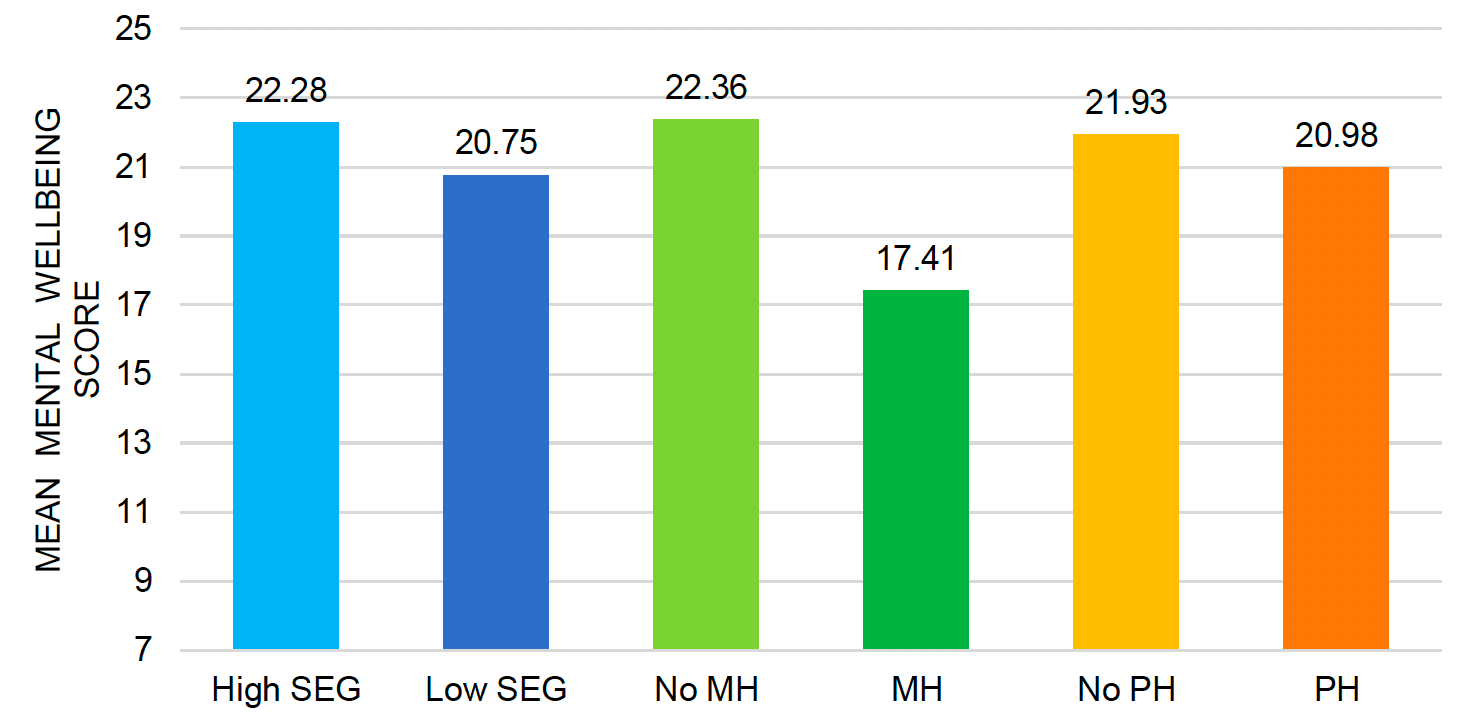
Differences in financial and home life circumstances also appear to be associated with mental wellbeing scores and indicate that those who have fewer responsibilities and more financial security have higher mental wellbeing. For example, people with no unpaid caring responsibilities had higher mean mental wellbeing scores (22.01) than those who are carers (20.40). Furthermore, those who did not experience any change in their working status during the COVID-19 pandemic reported higher mental wellbeing (22.44) than those who did experience change in their working status (20.75), such as being furloughed or losing one's job. Finally, those with access to outdoor space at home reported higher mental wellbeing (21.89) than those with no access to outdoor space (19.82).
Changes across the waves
Analysis suggests that levels of average mental wellbeing for the overall sample increased from Wave 3 (21.69) to Wave 4 (22.15), and levels of mental wellbeing at Wave 4 (22.15) were higher than Wave 1 (21.86) and Wave 2 (21.78), as illustrated in Figure 2.14.
An increase in levels of mental wellbeing from Wave 3 to Wave 4 was found for the following subgroup:
- Respondents in the higher SEG
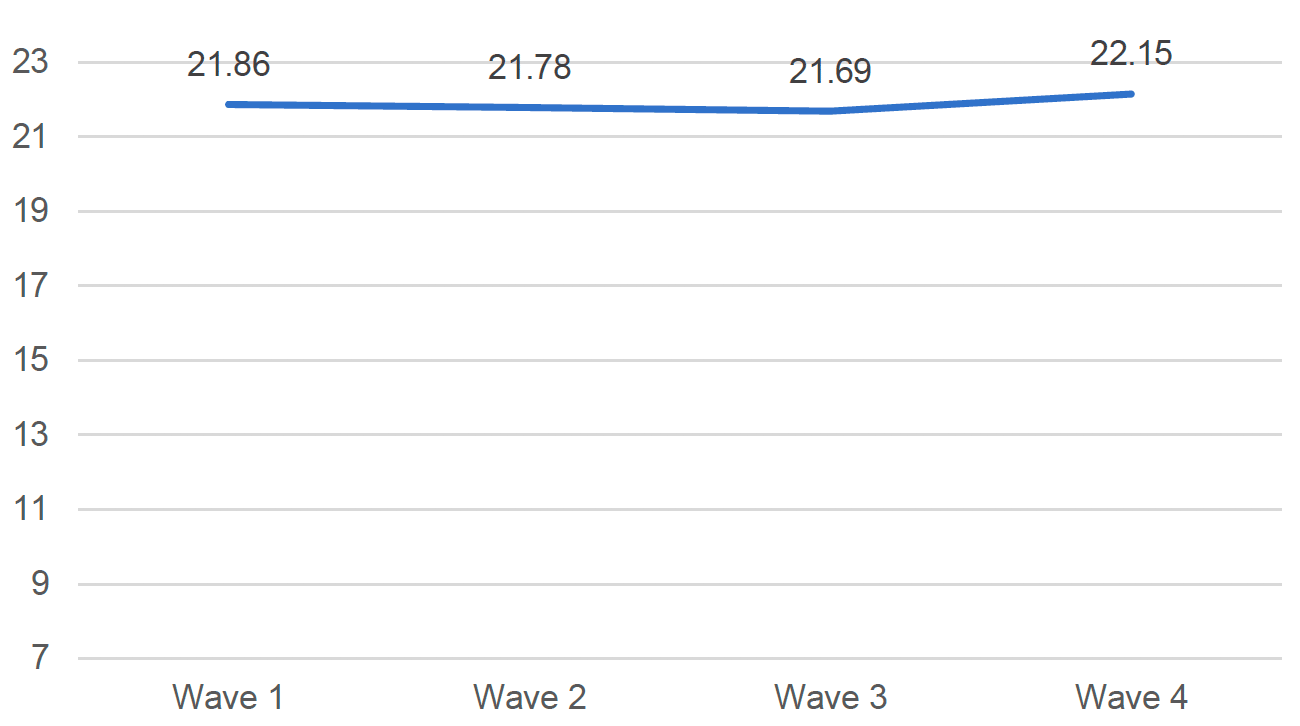
There were no statistically significant differences in the changes across the waves in mental wellbeing by age and sex. Specifically, mental wellbeing for those aged 30-59 years for both women (Wave 3: 20.33; Wave 4: 21.23) and men (Wave 3: 21.68; Wave 4: 22.05) did not change. Additionally, levels of mental wellbeing remained similar for both women (Wave 3: 23.28; Wave 4: 23.37) and men (Wave 3: 23.26; Wave 4: 23.64) aged 60+ years. Due to the loss at follow-up, it is not possible to report the changes for the 18-29 year old age group over the waves.
There were some changes in levels of mental wellbeing over the waves by background and health factors, which are displayed in Figure 2.15. Specifically, respondents from the higher SEG had an increase in mental wellbeing from Wave 3 (22.22) to Wave 4 (22.84). As most subgroups increased in mental wellbeing in similar levels from Wave 3 to Wave 4, no further subgroup differences were reported.
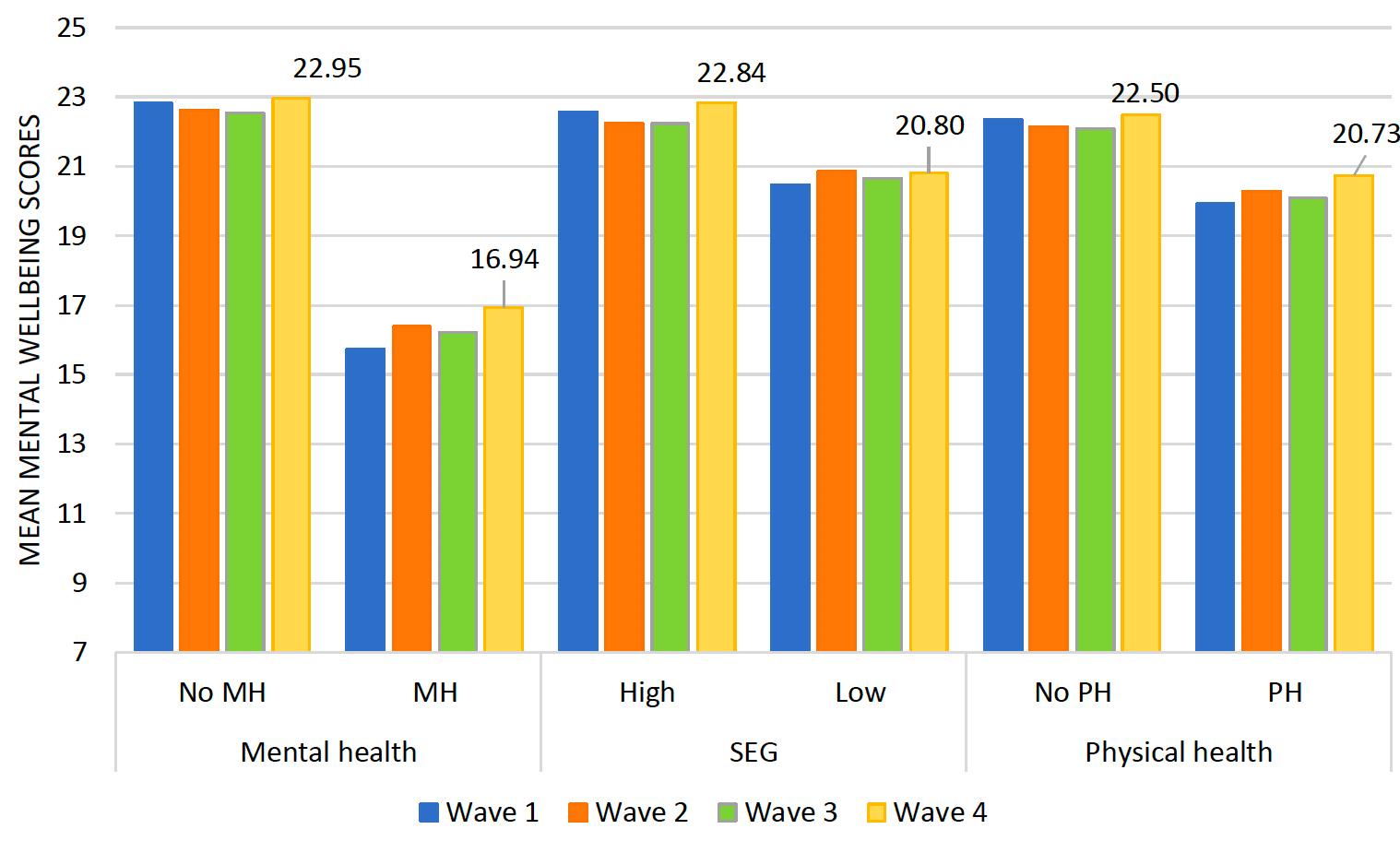
2.6. Other mental wellbeing outcomes
Wave 4 of the SCOVID Mental Health Tracker Study assessed a range of other indicators and correlates of mental health and wellbeing. These included feelings of defeat, entrapment, loneliness, life satisfaction, and distress. This section provides a brief overview of these measures, and findings suggest that the subgroups most at risk of poor mental health and wellbeing (compared to their subgroup counterpoints) are:
- Women
- Young adults (18-29 years)
- Those with a pre-existing mental health condition
- Those in the lower SEG
2.6.1 Loneliness
We measured loneliness using the UCLA Loneliness Scale (Hughes et al., 2014), which assesses 3 aspects of loneliness, namely: lacking companionship, feeling left out, and feeling isolated from others. We asked people how often they felt each of these aspects of loneliness in the week prior to responding to the Wave 4 questionnaire.
A total loneliness score was created by adding the responses to each question together, creating a score between 3, indicating no loneliness, and 9, indicating high levels of loneliness. As there is no cut-off score demarcating high and low levels of loneliness, mean scores were reported when comparing the different subgroups in terms of perceived levels of loneliness.
Wave 4 findings
The mean score for loneliness for the whole sample at Wave 4 was 5.01 out of a maximum of 9 (where a higher score means higher loneliness). There were a number of clear differences in terms of levels of loneliness by age and sex. For example, women reported being lonelier (5.21) than men (4.80). Additionally, young adults (18-29 years) had the highest levels of loneliness (5.42), compared to 30-59 year olds (5.01) and 60+ year olds (4.72).
Subgroup analyses indicated that respondents' background and health may also be associated with higher levels of loneliness (see Figure 2.16). Specifically, respondents in the lower SEG reported higher mean loneliness scores (5.24) than those in the higher SEG (4.88). Additionally, people with a pre-existing physical health condition reported experiencing higher loneliness (5.47) than those with no pre-existing physical health condition (4.88). Individuals with a pre-existing mental health condition reported higher loneliness (6.08) compared to those with no pre-existing mental health conditions (4.85).
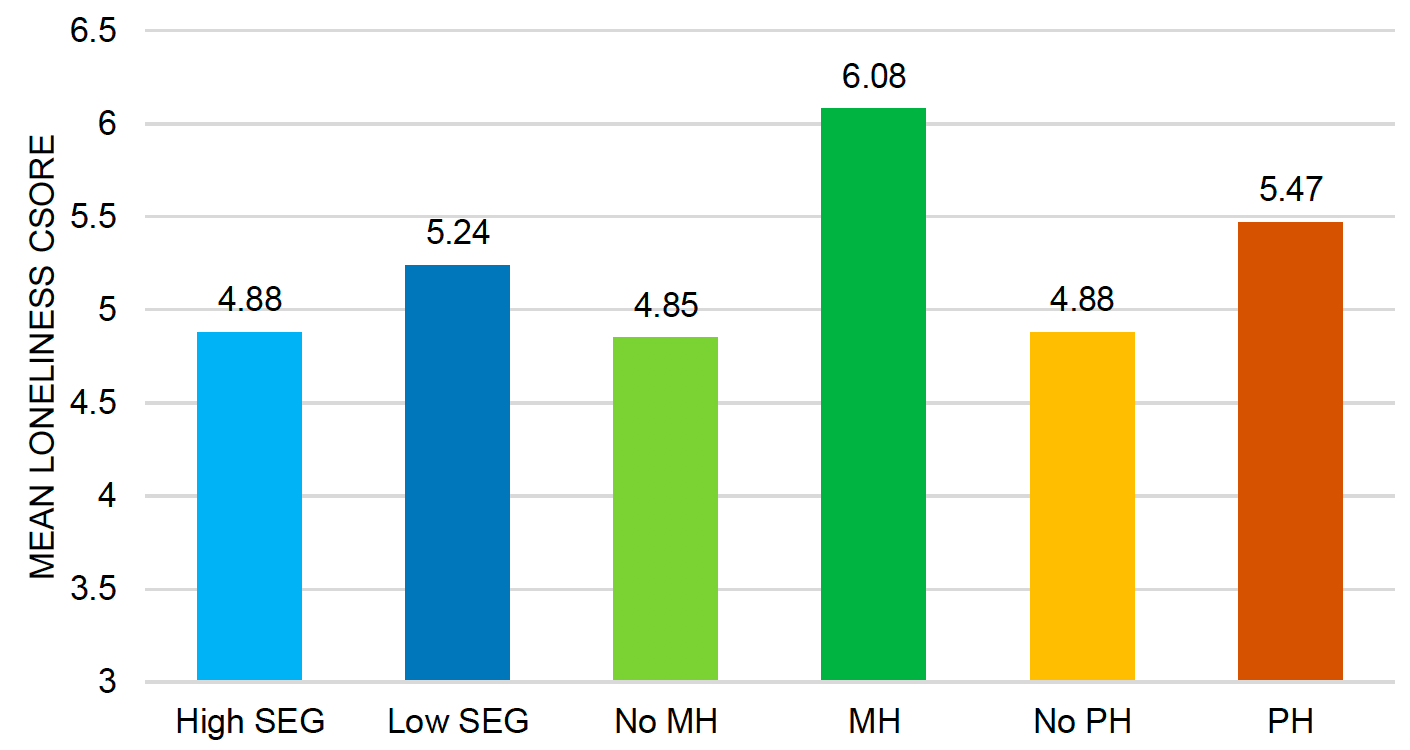
Changes across the waves
For the whole sample, feelings of loneliness increased from Wave 3 (4.71) to Wave 4 (4.83), which brings it to a similar level of that reported at Wave 1 (4.89).
Some subgroups reported an increase in loneliness from Wave 3 to Wave 4, including:
- Respondents from the lower SEG
- People with caring responsibilities
- Respondents who had dependents under 16 years old in their household
Looking at age and sex, as loneliness increased for all subgroups, there were no statistically significant differences between the subgroups in changes in levels of loneliness from Wave 3 to Wave 4.
Some differences in changes in levels of loneliness over time were reported for background and household subgroups. Respondents from the lower SEG reported that their loneliness increased from Wave 3 (4.96) to Wave 4 (5.21), compared to those in the higher SEG, whose levels of loneliness remained similar (Wave 3: 4.57; Wave 4: 4.64). Additionally, people who had caring responsibilities reported that their loneliness had increased from Wave 3 (4.40) to Wave 4 (4.90), compared to individuals with no caring responsibilities (Wave 3: 4.75; Wave 4: 4.83). Finally, respondents who had dependents under 16 years old in their household reported an increase in levels of loneliness from Wave 3 (4.56) to Wave 4 (4.81), compared to those with no dependents (Wave 3: 4.75; Wave 4: 4.84).
2.6.2 Defeat and entrapment
Feelings of defeat and entrapment are important indicators of mental health, and have been associated with depression, anxiety, and suicidal thoughts. Defeat is a feeling of powerlessness in life and entrapment is a feeling of being trapped by circumstances or your own thoughts. Defeat was assessed using the short form of the Defeat Scale (Gilbert & Allan, 1998; Griffiths et al., 2015) and entrapment using the short form of the Entrapment Scale (Gilbert & Allan, 1998; De Beurs et al., 2020). All respondents are given a score for each measure by adding together each question response, with 0 indicating no feelings of defeat or entrapment and 16 indicating a very high level of feelings of defeat and entrapment. There are no cut-off scores for defeat and entrapment measures to demarcate high or low levels of defeat and entrapment, therefore an average mean score is used to compare differences between the subgroups.
Wave 4 findings
The overall mean score for the sample was 3.87 for defeat and 3.52 for entrapment.
Investigating the subgroups, there were some differences in relation to age and sex on feelings of defeat and entrapment. Findings suggests that young adults and women were at higher risk for feeling defeated and entrapped. For example, young adults' (18-29 years) mean scores on defeat (4.72) were higher than those aged 30-59 years (4.30) and those aged 60+ (2.61). Similarly, for feelings of entrapment, young adults (18-29 years) scored higher on entrapment (4.57) than those aged 30-59 years (3.92), which was higher than those aged 60+ years (2.14). Regarding the differences by sex, women reported higher mean scores on defeat (4.25) than men (3.47), and women reported higher levels of feeling entrapped (3.88) than men (3.13).
Other background and health factors appear to be associated with differences in feelings of defeat and entrapment. Respondents in the lower SEG felt more defeated (4.23) than those in the higher SEG (3.67). In addition, those in the lower SEG scored higher on entrapment (3.91) than those in the higher SEG (3.30). Moreover, respondents who indicated having a mental health condition scored higher on defeat (7.99) than those with no pre-existing mental health condition (3.26). Similarly, the entrapment mean score among those with a mental health condition was higher (8.06) than of those with no pre-existing mental health diagnosis (2.84).
Changes across the waves
For the whole sample, average defeat scores were higher at Wave 4 (3.95) than both Wave 2 (3.74) and Wave 3 (3.76), but similar to Wave 1 (3.86). Average entrapment scores at Wave 4 (3.70) were similar to Wave 3 (3.59), but were higher than those at Wave 1 (3.38) and Wave 2 (3.27).
The following groups reported that their average defeat and entrapment scores had changed from Wave 3 to Wave 4:
- Men aged 30-59 and 60+ years reported an increase in defeat
- Those with no pre-existing mental health condition reported an increase in defeat, while those with a pre-existing mental health condition reported a decrease in entrapment
- Respondents from the lower SEG reported an increase in levels of entrapment
- Respondents who had caring responsibilities reported an increase in defeat and entrapment
- Individuals who are key workers reported an increase in defeat and entrapment
Looking more closely at subgroup changes in defeat and entrapment by age and sex, differences emerge. For men aged 30-59 years, defeat scores increased from Wave 3 (3.43) to Wave 4 (3.90), as well as for men aged 60+ years (Wave 3: 2.34; Wave 4: 2.59). There were no statistically significant changes for entrapment for age and sex subgroups.
There were also some changes over the waves by background and health factors. People without a pre-existing mental health condition reported that their defeat increased from Wave 3 (2.96) to Wave 4 (3.19) but reported no change in entrapment scores (Wave 3: 2.71; Wave 4: 2.88). This is compared to those with a pre-existing mental health condition, who reported no change in defeat scores (Wave 3: 8.95: Wave 4: 8.84), however a decrease in entrapment scores (Wave 3:9.25 to Wave 4:9.00). Despite these changes, those with a pre-existing mental health condition reported higher defeat and entrapment at all waves compared to those without.
Respondents from the lower SEG reported an increase in levels of entrapment from Wave 3 (3.48) to Wave 4 (3.93), compared to the higher SEG who reported similar levels at both waves (Wave 3: 3.65; Wave 4: 3.59). Those who were carers' reported an increase in levels of defeat (Wave 3: 4.38; Wave 4: 5.21) and entrapment (Wave 3: 3.63; Wave 4: 4.56). Additionally, respondents who were key workers reported in increase in their levels of defeat (Wave 3: 3.29; Wave 4: 4.08) and entrapment (Wave 3: 3.31; Wave 4: 3.76).
2.6.3 Resilience
How resilient a person is can be important for understanding their capacity to cope with difficulties and recover from hardship and stress. Being resilient can be protective for mental health problems, including depression, anxiety, and suicidal thoughts. Resilience was assessed using 4 questions from the Brief Resilience Scale (BRS; Smith et al., 2008).
Respondents received a total score by summing the responses to each question, and this ranges from 0, indicating very low resilience to 16, indicating very high resilience. As there are no cut-off scores to demarcate levels of high and low resilience, mean scores were used to compare the different subgroups on resilience. Respondents were asked to rate their perceptions of their resilience in the 7 days prior to responding to the Wave 4 questionnaire.
Wave 4 findings
Across the whole sample, the mean resilience score was 10.64, out of a possible 16.
The subgroup analyses revealed some differences in mean resilience scores by age and sex. Specifically, mean resilience scores were higher for men (10.99) compared to women (10.33). Levels of resilience varied by age group, with the older age group (60+ years) reporting the highest levels of resilience (12.16), followed by 30-59 year olds (10.08), and young adults reported the lowest levels of resilience (9.72).
Respondents' perceptions of their resilience and ability to cope with stress varied by background and health status. For example, levels of resilience were higher for those in a higher SEG (10.92), compared to the lower SEG (10.16). Individuals with a pre-existing mental health condition also reported less resilience (6.68) compared to those with no mental health condition (11.23).
Changes across Waves
Across the whole sample, levels of resilience decreased from Wave 2 (10.63) and Wave 3 (10.52) to Wave 4 (10.37), although resilience scores at Wave 4 were not different from Wave 1 (10.48). Analysis suggests that levels of resilience decreased for women aged 30-59 years from Wave 3 (9.85) to Wave 4 (9.48), as well as for men aged 30-59 years from Wave 3 (10.70) to Wave 4 (10.43), compared to the other age and sex subgroups. For those with a pre-existing mental health condition, levels of resilience increased from Wave 3 (5.83) to Wave 4 (6.14), compared to the decrease seen among those with no mental health condition (Wave 3: 11.25. Wave 4: 11.02), who still remained higher overall.
2.6.4 Social support
Questions assessed sources of emotional and physical support and feelings of connection to those around the respondents. Good support networks are important to protect against poor mental health, including against depression, anxiety, and suicidal thoughts. Social support was measured using four questions from the ENRICHD Social Support Instrument (ESSI; Mitchel et al., 2003) that assess how often an individual feels they currently have emotional and physical support.
Responses are summed into a total score, with a potential range from 4, indicating low social support, to 20, indicating very high social support. Therefore, higher scores represent higher levels of social support.
Wave 4 findings
For the whole sample, the mean score for levels of social support was 14.19. There were some differences in perceptions of social support by age and sex. Interestingly, at Wave 4 young adults (18-29 years) reported the highest levels of social support (14.75), higher than individuals aged 60+ years (14.38). The lowest social support was seen in the 30-59 year olds (13.80). There were no statistically significant differences in social support between men (14.22) and women (14.15).
Respondents' background and health status also were associated with different levels of social support, with those most at risk of negative outcomes such as depression and anxiety reporting lower social support. Specifically, individuals in the higher SEG reported more social support (14.73) than those in the lower SEG (13.25). Respondents with no pre-existing physical health condition reported higher levels of social support (14.46) than those without a pre-existing physical health condition (13.22). Additionally, individuals with no pre-existing mental health condition reported higher levels of social support (14.44) compared to those with a pre-existing mental health condition (12.50). This suggests that those with a pre-existing mental health condition, in particular, have less sources of social support, a key protective factor for poor mental health.
Changes across Waves
For the whole sample, social support average scores decreased from Wave 3 (14.62) to Wave 4 (14.42), and were similar at Wave 4 to Wave 1 (14.37) and Wave 2 (14.42). Analysis suggests that there were no statistically significant changes in levels of social support between the age and sex subgroups from Wave 3 to Wave 4.
Respondents with a pre-existing mental health condition reported that their social support increased from Wave 3 (12.15) to Wave 4 (12.65), and those without a pre-existing mental health condition reported a decrease in social support from Wave 3 (15.01) to Wave 4 (14.69).
2.6.5 Distress and life satisfaction
Distress is a feeling of acute anxiety and pain, and it is a correlate of current and future mental wellbeing. To measure levels of distress, we asked respondents to indicate on a 10-point scale how distressed they had felt in the past week, on a range of 0, indicating feeling no distress, to 10, indicating feeling extreme distress.
Respondents were also asked about their current life satisfaction with the question 'All things considered, how satisfied are you with your life as a whole nowadays?' They were asked to rate their life satisfaction on a scale from 0, indicating extremely dissatisfied to 10, indicating extremely satisfied. As there is no cut-off for high and low distress, the subgroups are compared on their average mean scores.
Wave 4 findings
For the whole sample the average level of distress was 2.79, which suggests mild levels of distress. Different levels of distress were found for age and sex. Specifically, women reported higher levels of distress in the week prior to the Wave 4 questionnaire (3.18) than men (2.37). Additionally, levels of distress varied across the different age groups, with young adults (18-29 year olds) reporting the highest levels of distress (3.90), followed by 30-59 year olds (2.86) and the 60+ group (1.88). Findings from young adults should be treated with caution due to the small sample size.
Levels of distress varied according to respondents' health. Of all the subgroups, the highest levels of distress were seen in those with a pre-existing mental health condition (4.61), higher than those with no previous mental health diagnosis (2.52).
Respondents in the lower SEG reported a greater level of distress (3.03) than those in the higher SEG (2.66). Respondents with a pre-existing physical health condition reported higher levels of distress (3.01) than those without a pre-existing physical health condition (2.73).
The average mean life satisfaction for the sample was 5.87, which suggests that overall, respondents were moderately satisfied with life. Looking at life satisfaction by age, young adults (18-29 year old) had the lowest life satisfaction scores (5.43), compared to the 30-59 year olds (5.69) and the 60+ year old group (6.48). Findings from young adults should be treated with caution due to the small sample size.
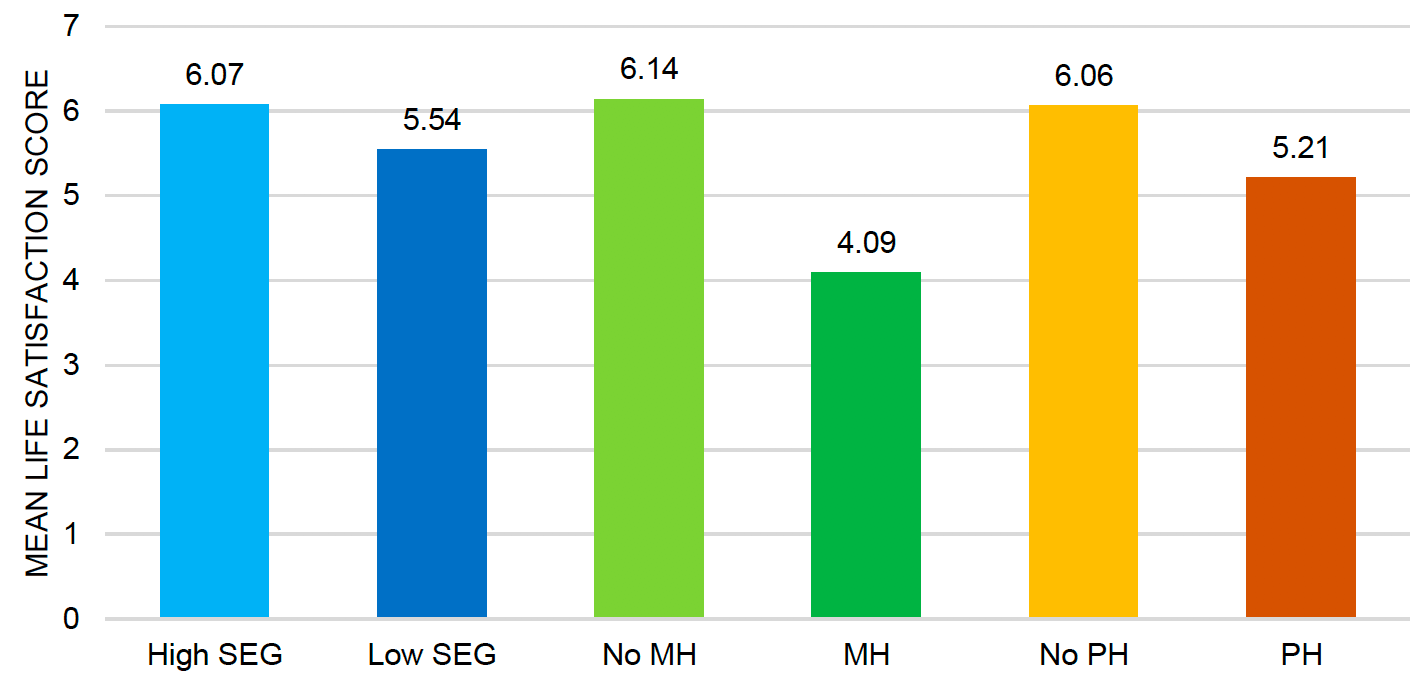
Subgroup analyses indicated that respondents' background and health may also be associated with higher levels of life satisfaction, as illustrated in Figure 2.17. Specifically, respondents in the higher SEG reported higher mean life satisfaction scores (6.07) than those in the lower SEG (5.54). Additionally, people without a pre-existing physical health condition reported experiencing higher life satisfaction (6.06) than those with a pre-existing physical health condition (5.21). Individuals with no pre-existing mental health condition reported higher life satisfaction during Wave 4 (6.14) compared to those with a pre-existing mental health condition (4.09).
Contact
Email: socialresearch@gov.scot
There is a problem
Thanks for your feedback